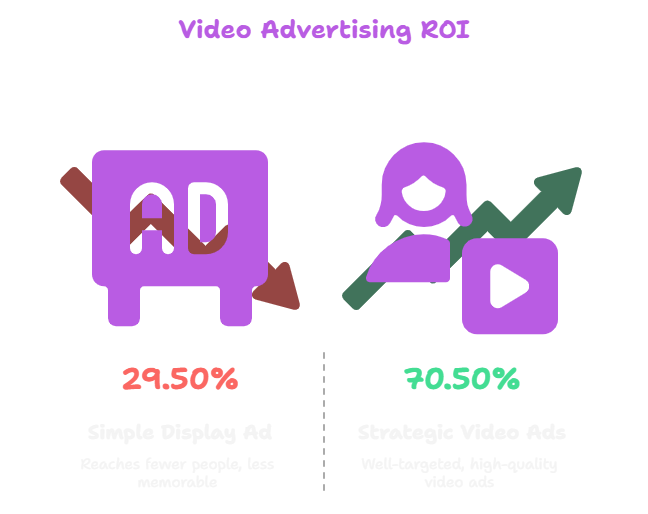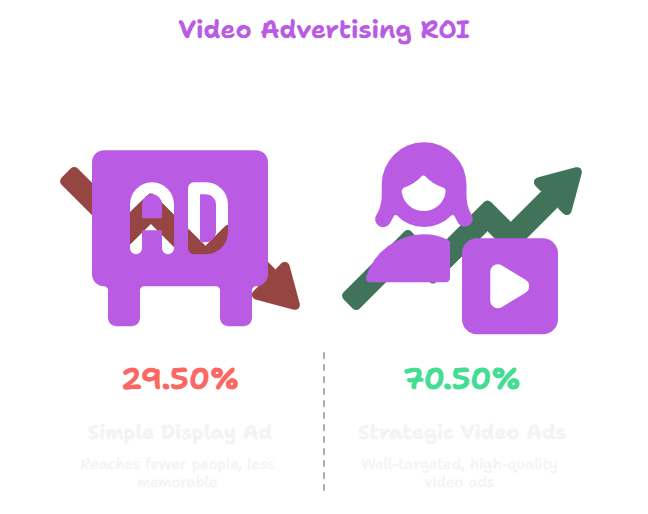Video Advertising in 2025: Why Your Brand Is Invisible Without It

Imagine this:You are going through your phone at 2 am (we do that too) when, all of a sudden, a 15-second clip catches your eye and screeches you to a halt. It might be something impossibly adorable, like a cat on Twitter doing something or product demos that make you go; I have to have this. And there you have it, the power of video advertising at work, and unless you are using video as part of your marketing, you might as well be standing in the middle of a dense forest shouting your message through a pair of noise-cancelling earphones.
This virtual reality check will turn the coffee of every single marketer cold: 96 per cent of all marketers claim that video advertising generates more knowledge about their product or service, and 95 per cent confirm more brand awareness. Unless you have stopped breathing after reading those figures, you should pivot your online marketing approach.
What Is Video Advertising? (And Why Static Ads Are So Last Decade)
Before we go into the meat of things, it is time to return to the beginning. Video advertising involves utilizing short but captivating video content to advertise your product, service or brand using online platforms. It is like a story told with a sales message covered with candy of visual images and a little spiced with, please click here and give us your money.
However, now the interesting part comes: video advertising is not about staging a nice video and wishing you good luck. It has to do with recognizing that it only takes 3 seconds to get a hold of someone's eyeballs in any given digital attention-deficit society where the swiping thumb over hits watching someone eat lunch or a dancing dog.
The shape and size of digital video ads vary widely: I mean those pre-roll ads on YouTube that start you thinking about the purpose of your life, waiting until the moment the button Skip Ad appears, and those on Instagram, which look like stories that you cannot clearly distinguish between ads and high-quality content. What makes contemporary video advertising look so nice is that it can do so many things during a single advertisement: Entertain, Educate, and Sell, all in 30 seconds.
The Evolution of Video Advertising: From "We'll Be Right Back" to "Swipe Up"

Do you recall what used to be the largest video advertising strategy choice: should you purchase a 30-second or 60-second television advertisement during prime time? Those times should be in a museum, along with dial-up modems and Nokia flips. In video advertising, not as many changes have taken place as in the Instagram account of a reality TV star.
What followed was a path of innocence, starting in 1941 when Bulova Watches ran the first-ever television advert; it was a mere 10-second advertisement that cost money that brands would spend on an average post of a TikTok influencer these days. Jump into the world of TV in the 40s to 90s, when long-form was the king of the medium, and brands could afford to take up a whole minute or so to get their message across.
Then came the digitalization of the 2000s, and all of a sudden, the game was changed when YouTube, Facebook, and Google Ads came into being to change how we think about video distribution. The brands no longer depended on TV schedules to reach their target audience noon or night with laser-pinpoint accuracy.
It all changed in the 2010s and 2020s as the mobile and social revolution of the 2010s and 2020s came along. TikTok, Instagram Reels, Snapchat and others did not only modify the rules; they got rid of the rulebook and said, Here, make people care about your brand in 15 seconds or less, and they are probably doing this while walking their dog.
The current state of online video advertising is personified, two-way and data-based to the extent that former generations of marketers would either be immensely thrilled about it or horrified. We will visit the audience like a Swiss watchmaker and a caffeinated art student.
The Science Behind Why Video Advertising Works
Now, let us discuss why video advertising is not yet another advertising bubble which will fade away quicker than a free lunch in a start-up office. The brain also interprets images 60,000 times quicker than text, so you can instantly remark whether or not a person is having a bad day by facial expression. In contrast, you need three passes to decipher that scary email accounting sent you.
The concept of video advertising is effective as it appeals to various senses simultaneously. Static ads only help viewers with visual effects and a sense of text, whereas video ads entail detailed movement, sound, narration, and emotional response. It is the same as the difference between reading about what it is like to ride a roller coaster and going on it and feeling those stomach-looping turns.
The persuasiveness of short-form video marketing has been able to reach new heights since it understands a simple truth about the attention span of human beings. As far as the capacity of most goldfish going short-term memory is concerned, the human attention span is even shorter, and there is nothing wrong with it. When done correctly, they can carry more information and an emotional touch than an article containing thousands of words.
It is interesting to learn the psychology of successful video advertising. We are programmed to react to face, movement and stories. With these things, a focus on strategic messaging, and a crisp call-to-action, you effectively put a neural highway regarding the purchase decision centre into your viewer's brain.
Mastering Video Ad Strategy: The Essential Ingredients for Success

Golden First Three Seconds
The first few moments in video advertising couldn't be a first impression during a job interview. You must attract the audience immediately with gesture, expression, or shock. It is not the moment to build the brands sneakily. This is where you take hold of the collar and will not release the grip. Maybe it is not a shocking figure, but a surprising image or a character performing an action which makes the audience go: wait, what? The initial three seconds determine whether a person will consume your message or scroll down to check what their former high school buddy ate in the morning.
Front-Loading your Value Prop
The bad news is this: the vast majority of the audience will not view all of your videos, no matter how smart they might be, in your opinion. This implies that your main message should be seen enough and on the first page. It is like writing a news item- the most vital facts will be in the first paragraph and not somewhere in the middle, where only avid readers will get it.
Quality that does not cost a fortune in production
The Hollywood budget should not stop you from producing persuasive video advertising because you need to know that the viewers can quickly differentiate between professional and amateur content. The wobbly cams, bad sound and jumpy cuts will kill your message quicker than a misspelt word in your resume. However, being professional does not imply that you were bought to be expensive; you are considerate, deliberate, and refined.
Platform-Specific Video Marketing Best Practices

Social Media Video Ads: Making Native Work
An excellent social media video ads strategy must be created without advertising as an advertising campaign. The most effective video advertising on social media is an inseparable part of the organic content on social media. At the same time, it contains some distinct brand messages. This could involve adopting trends and challenges on TikTok. LinkedIn may entail thought leadership content that happens by chance to indicate your expertise. It is all about visual storytelling on Instagram that will not scroll.
Mid-roll and Pre-roll Ads: Trapping Captive Audiences
Pre-roll and mid-roll video ads have their niche in the video advertising system. They already want to watch something and are, therefore, in the right frame of mind to get into what you have to offer, but at the same time, they are likely to be anxious to see what they came to see. It all depends on delivering value, even in these small interruptions. Ensure that your pre-roll ads are engaging so that the viewers are not bothered by the advertisement delay or educative so that the viewer feels that the delay was laden with useful information.
Designing the Thumbs and Short Attention Spans to Mobile Video Ads
Mobile video advertisements have a new approach compared with desktop ones. Vertical is more effective than horizontal; text wants to appear large so it is readable on small screens, and audio is unreliable because most browsers have it turned off. Mobile video advertising is all about thumb-stopping content that performs, whether with or without a piece of sound.
Interactive Video Content: The Future Is Already Here
Video advertising is moving toward becoming interactive, and the one that takes it on early enough will gain a great competitive advantage over others. When the content of videos is interactive, it enables the audience to directly navigate your advertisement video by clicking on things they see, such as items, choosing their adventure-like action, or responding to polls.
This is not mainly about slapping bells and whistles just to be innovative. Video advertising elements can dramatically enrich the level of engagement and make the necessary data regarding the preferences and behaviours of the viewers. When they go to something in your video ad and click on something, they are already raising their hand and saying that they are interested in this particular thing and that it is worth its weight in gold (or should I say gold) in both the short run conversion and in how to communicate in targeting with them in the future.
The technology underlying interactive video content has grown ever more advanced to enable the smooth implementation of clickable items, on-the-managed customization and even augmented reality usage. When a brand understands how to use these elements of interactivity, engagement levels and higher-quality leads will be their new reality.
Measuring Success: Beyond Views and Likes
The old-fangled parameters, such as the number of views and likes, are good to boast about. Still, they do not completely reflect the reality of the effectiveness of video advertising.
The ultimate indicator of success is to break down the entire customer purchasing pathway through the initial glance up to the final purchase.
There is an emphasis on completion rather than views since they show the actual level of engagement. The interest of a video consisting of 10,000 views of 5 percent completion and a video containing 1,000 views and 75 per cent completion is not worth it. ROAS, conversion rates, and click-through rates give a lot clearer images of performance video advertising.
Now, advanced forms of analytics can monitor micro-interactions in the videos where people pause, rewatch, or abandon. Such precise data will assist in planning better video ad strategy in the future by pointing out the most compelling parts and the locations where interest has been lost.
The Technical Side: Optimizing for Every Screen and Speed
Video advertising in 2025 will entail looking forward to an unbelievably diversified technical environment. Your text must be perfect on the newest iPhone or the oldest tablet your aunt still uses to open Facebook. This means you must consider file sizes, speed, and format compatibility at the start of your production process.
Compression technology developed, and nowadays, the videos are of high quality, and the load speed is fast even with slow connections. Nevertheless, even the superior video advertisement approach involves formats optimized for various platforms and degrees of connection. The principle of auto-adapting content delivered by providing the highest quality version that a user device and connection can support will guarantee a superior viewing experience.
Deadfalls and Methods of Avoiding Them
Video advertising campaigns will come as a flat turn despite the good intentions. The most frequent error is production that is too oriented on old-time advertising in places where originality is preferred to smoothness. The other common mistake is ignoring the significance of captions and image-based narrative in the sound-off conditions of viewing.
Another common pitfall many brands use is the attempt to include as much information as possible in short-form video marketing. This has been the temptation too many times in the past to put all of the product features, benefit statements, and calls to action into a 15-second video that ends up as totally mixed up, confusing content that says nothing.
The ROI Reality: What Video Advertising Delivers

The elephant in the room: Let us get to the point: does video advertising make better returns than other digital marketing strategies? The response will be a loud yes to this question, although it should be noted that there are critical issues to consider in both implementation and assessment.
Video advertising, which is high-quality and properly targeted, always works better than a simple display ad by reaching more people and causing them to remember the brand and take action. But the keyword here is well-targeted. Ineffectively done video advertisement can even be less effective, unlike its simpler version, yet it is expensive to shoot.
Brands that use video advertising as a strategic move instead of a tactical action have been enjoying the best returns on their purchase. They invest in getting to know their audiences, trying and testing out different strategies, and then constantly making their strategies perform best based on their performance data.
Looking Forward: The Next Phase of Video Advertising
As we enter more and more into 2025, video advertising is developing unprecedentedly. The traditional candidates to generate personalized video content on a large scale include artificial intelligence, which will enable brands to produce thousands of similar topical variations of the same message directed to particular audience segments.
Considered experimental just a few years ago, virtual and augmented reality is becoming practical in providing an immersive brand experience. There are voice-activated interactions and shoppable video content, but it is already a fact and not a new experiment.
The brands that come out on top in the next era of video advertising are the ones that realize that it is not the innovative technology or the largest budget that matters and that it is the ability to continually produce content that is of value that delivers the interesting stories and to connect with real people.
Conclusion: Your Video Advertising Revolution Starts Now
Video advertising is not an additional feature on your digital marketing shopping list, but the camera or nothing scenario that will either make your name known to the digital world of attention or will be another example of your unheard ultimate obscurity. The video marketplaces of 2025 will be won by the ones that realize the art and Science of video advertising: bringing together creative storytelling with targeting and continuous optimization.
The technologies have never been more advanced, allowing people to quickly access the unsurpassed barriers to entry and carry around the most powerful tools they have ever had to use. Audiences have never been friendlier to video content. It no longer matters whether you are new to video advertising or feel that there is more you want to do. It has to be done with much or minimal effort.
You should not ask yourself whether you can afford to invest in video advertising but whether you can afford not to do it. Video advertising is not only the way you play the game but also the way to win in a world where consumer attention is the ultimate currency.
Take that camera (or an expert who will know how to work it and get you some neat results without ripping your wallet out), get ready to add the stylish mess of creative storytelling to it, and set out to create some video advertising programs that attract more than an eye, attract an audience, win a heart, a mind, and a market share. The revolution will be televised, streamed, shared and measured in real-time. Ensure that you do not spectate on the sidelines.
Latest Posts

Micro vs Macro: Rethinking Influencer ROI in the Creator Eco...
Micro or macro influencers? Discover which drives ...

Audience Engagement Strategies for 2025
Unlock top strategies to boost content interaction...

The Ultimate Guide to AI Search Engine Rankings
Learn how to optimize for AI search engines like ...
